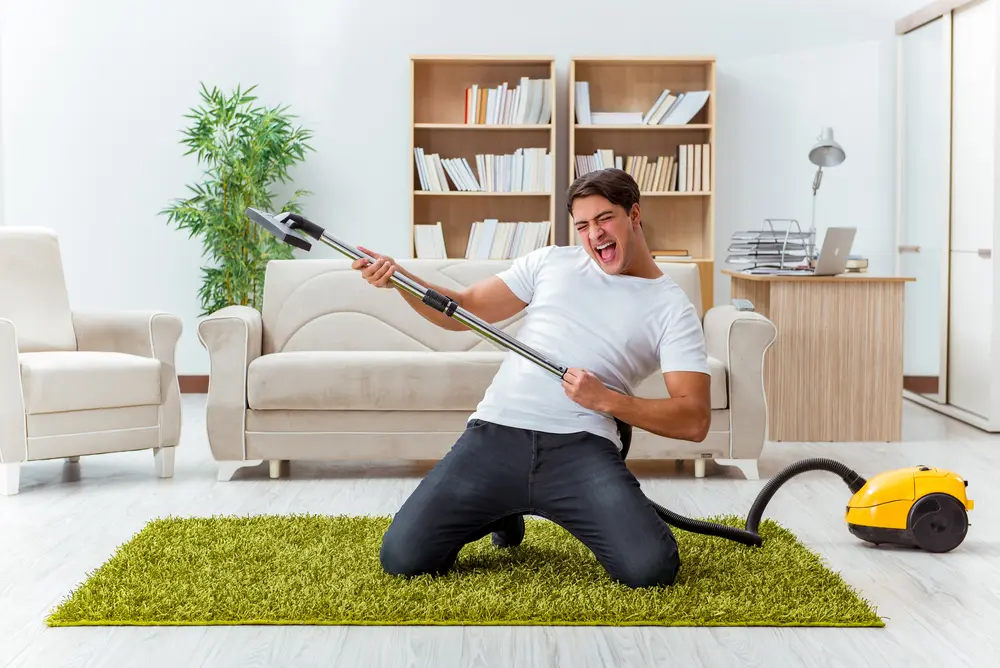When it comes to area rug cleaning, you need clear, actionable information. How can you remove that stubborn stain? What’s the best way to maintain your rug without wear and tear? This article answers these questions directly, offering practical techniques for taking care of any rug type. Get ready to learn how to tackle spills, daily dirt, and more with confidence.
Key Takeaways
- Understanding the material of your area rug is crucial for selecting appropriate cleaning methods and solutions, ensuring proper care and maintenance.
- Using the right tools and techniques is essential for DIY rug cleaning, such as gentle shampoos for natural fibers and specialized cleaners for synthetics, as well as regular vacuuming to preserve the rug’s integrity.
- For deep cleaning, prepare the space and rug thoroughly, use suitable cleaning products, and ensure proper drying to avoid damage, with special care for antique, oriental, shag, or open weave specialty rugs.
Understanding Area Rug Materials
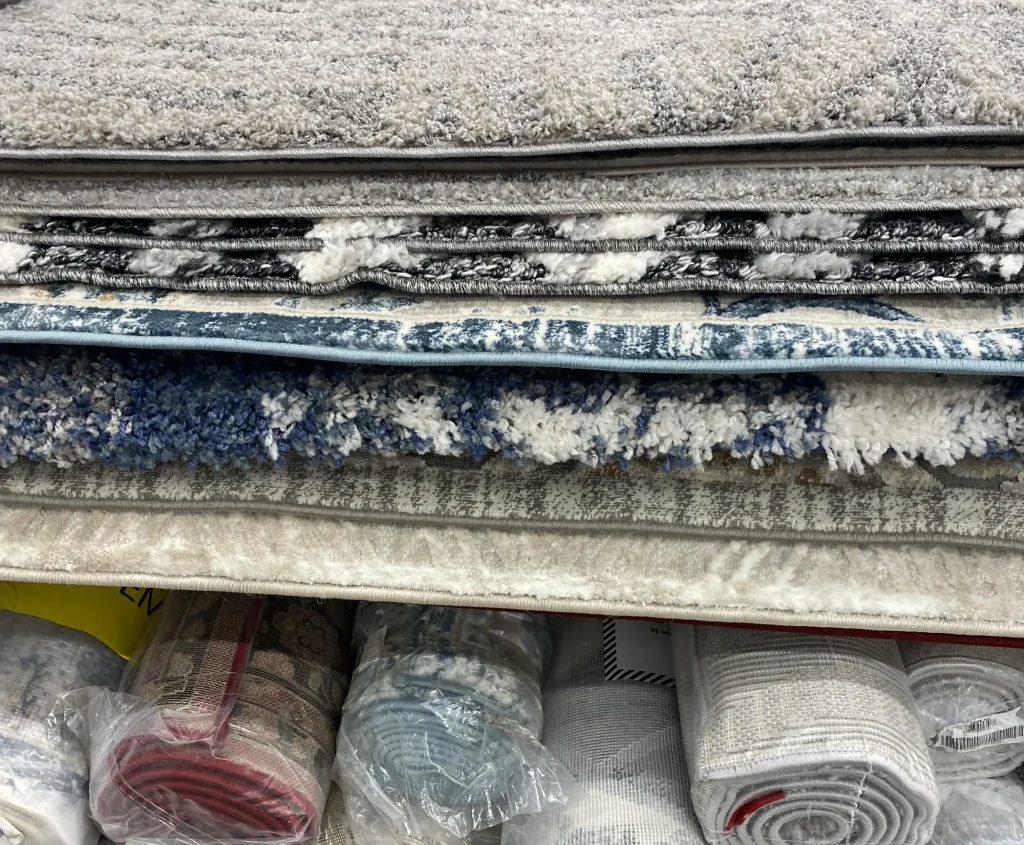
Area rugs are available in a variety of materials, each with its unique characteristics and maintenance requirements. These include wool, cotton, and synthetic fibers like polypropylene and nylon. Wool and cotton are popular choices due to their soft texture.
Knowing the material your rug is made of is crucial for proper cleaning and upkeep. This information will help you choose the right cleaning solutions and techniques that will keep your rug in excellent condition. Whether it’s an extravagant silk oriental rug or a resilient synthetic option, understanding its fibers ensures longevity for years to come.
Identifying Your Rug’s Material
If you happen to have purchased an area rug without a label specifying its material, there’s no need to worry. There are effective ways to determine the composition of your rug. One reliable approach is conducting a burn test on a small sample of its fibers. Synthetic fibers will liquefy and give off a plastic-like smell, while natural fibers will disintegrate and produce the odor of burning hair or paper. Another indication lies in examining how the rug was constructed. Usually, synthetic rugs feature hard plastic backing and evenly-made artificial fringes, whereas hand-knotted features are more common in natural fiber rugs.
Knowing what material your rug is made from goes beyond mere curiosity – it plays an essential role in maintaining it properly. Being aware of its constitution enables you to identify suitable cleaning methods that guarantee durability and preserve shine for years.
Cleaning Considerations for Different Fibers
Understanding how to effectively clean your rug begins with identifying its material. Each type of rug requires different cleaning techniques, such as being gentle when washing woolen and cotton fibers by using a mild liquid dish soap mixed with warm water to prevent damage or shrinking. For synthetic rugs, it is best to use a product like Ultimate All Fiber Rinse that protects the fibers while removing dirt and stains.
Silk fibers are commonly found in oriental area rugs and require special care due to their delicate nature. Regular brushing or vacuuming helps maintain them in good condition for longer periods of time. Jute and sisal fiber rugs also need regular vacuuming but should be spot-treated rather than scrubbed, steamed, or fully immersed in water, which can cause shrinkage or distortion.
Understanding these unique cleaning requirements based on your specific rug’s material allows you to adapt your methods accordingly without compromising its beauty. Remember, not all materials react the same way, so take extra caution when dealing with silk or natural plant-based rugs.
Essential Equipment for DIY Rug Cleaning

When it comes to DIY rug cleaning, knowing the material of your rug and its specific cleaning needs is crucial. To effectively clean your rugs at home, you will need a few essential tools and solutions on hand. These include a vacuum cleaner, carpet cleaner, foam remover for removing foam from soapsuds during the shampooing process, stain remover (for tackling tough stains), and an air scrubber.
It’s also important to select appropriate cleaning solutions based on the material of your rug. For example, synthetic fiber rugs can benefit from using a prespray specifically designed for synthetic fibers. In contrast, cotton area rugs may be cleaned with warm water diluted with mild liquid dish soap. Choosing the right combination of tools and cleaners tailored to your particular type of rug ensures that it not only stays free from germs but also maintains its appearance over time.
Please keep in mind that selecting suitable products based on the suggestions will definitely improve the overall results of your efforts in keeping them fresh, clean, and germ-free. Through a combination of appropriate tool choices and smart detergent selection, rugs can remain spotless for much longer periods.
Selecting the Right Cleaning Solutions
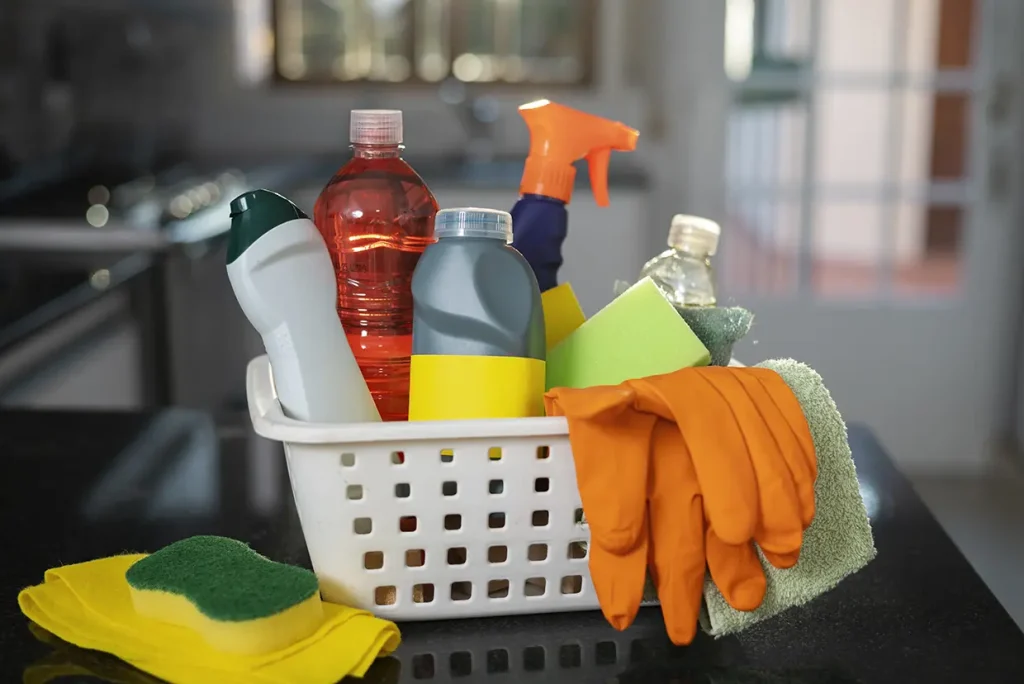
Finding the right cleaning solution is essential in maintaining your rug’s beauty and durability. The Carpet and Rug Institute suggests various methods for different types of rugs.
For synthetic fiber rugs, products like Ultimate All Fiber Rinse or specific sprays designed for these fibers can be used. When it comes to cotton area rugs, a mixture of mild liquid dish soap with warm water or a combination of detergent and white vinegar works well.
Tough stains on any type of rug require special attention. For silk rugs specifically, blotting the stain with equal parts water and white vinegar is recommended by experts at the Carpet and Rug Institute. In cases where an area has stubborn dirt buildup, using gentle powdered carpet shampoo may prove effective. A natural alternative that combines equal amounts of white vinegar mixed with water can also work wonders when trying to clean stains from all kinds of carpets.
These proven techniques provided by trusted sources such as CRI are guaranteed to provide excellent results when tackling tough messes on large room-sized pieces or smaller throw-style carpets alike!
The Role of Tools in Protecting Rug Fibers
Proper tools are essential in maintaining the quality of your rug’s fibers when cleaning. The type of tools used can greatly affect the condition and longevity of the fibers. Cleaning products with harsh chemicals should be avoided, as they have been known to cause damage over time. Opt for gentle, user-friendly products that work well with modern cleaning equipment.
To effectively clean your rug without causing harm, consider utilizing these helpful tools: a carpet rake, hot water extraction machine, and vacuum cleaner. You’ll most likely need a clean towel and stain remover to remove stubborn stains.
If using a brush, select one made from high-performance synthetic materials and sturdy bristles. This will guarantee a thorough cleaning while minimizing potential fiber damage risks.
Remember to choose carefully when selecting appropriate tools for washing or upkeep on carpets (especially those labeled sensitive) so you don’t inadvertently shorten their lifespan! Rugs require special care due to their delicate nature. This includes avoiding abrasive cleaners by sticking only until they are effective. This includes being cautious with the use of cleaning agents, ensuring that they are effective without overuse. Excessive amounts of harsh chemicals can embed themselves within the fabric of the rug, leading to potential damage and necessitating increased maintenance over time.
Step-by-Step Guide to Regular Rug Maintenance
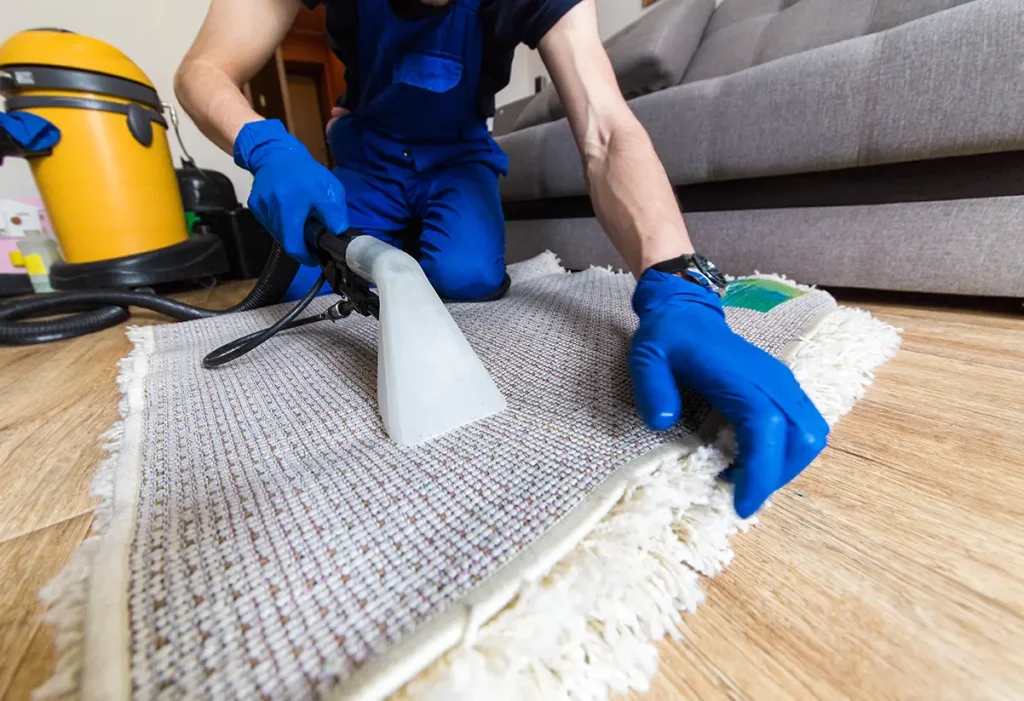
Proper and regular area rug cleaning is essential in preserving the appearance. This includes weekly vacuuming, or twice a month for wool rugs, to keep them looking their best. It’s also important to address spills and stains immediately by blotting rather than rubbing them.
To properly vacuum an area rug:
- Avoid going against the direction of its nap.
- Begin at one top corner and move down in straight lines from side to side following the weft lines or nap.
Regular vacuuming not only helps maintain the carpet’s appearance but also removes dirt buildup that can damage your rug over time. So be sure to make it part of your routine cleaning process!
Vacuuming Techniques for Longevity
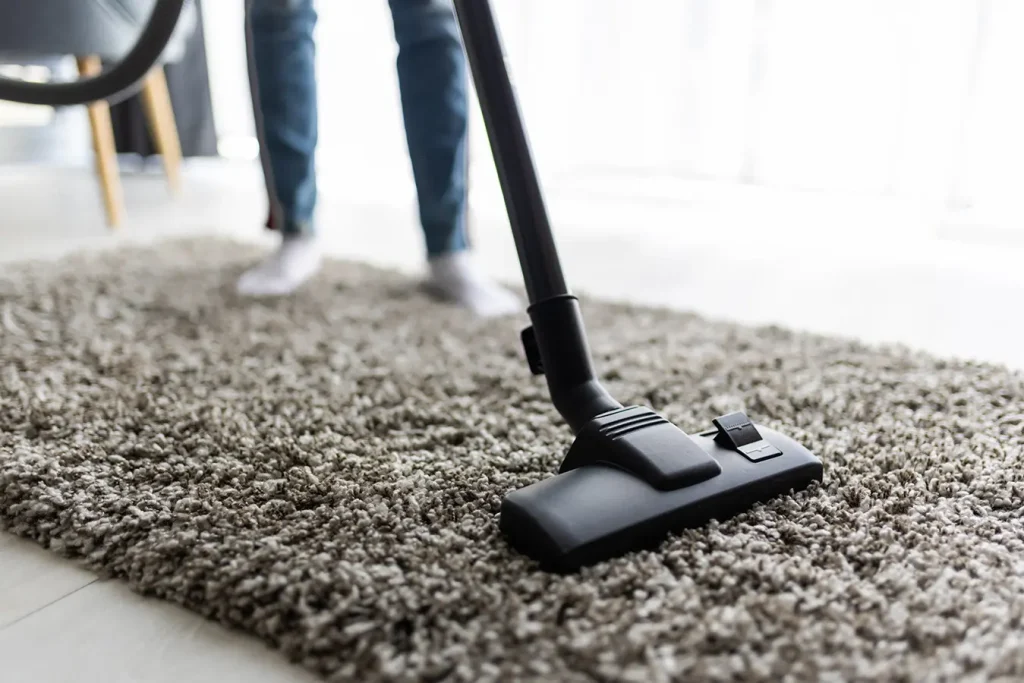
Area rug cleaning goes beyond a simple household chore – it is an essential step that can extend the life and appearance of your area rugs. To properly vacuum an area rug, follow these steps:
- Avoid going against the grain or nap.
- Begin at one corner and move downwards in a straight line.
3.Gently go from side to side following either the weft lines or direction of the nap.
For optimal maintenance, it is recommended to:
- Vacuum your rug at least three times per week
- Use caution when vacuuming by avoiding aggressive movements and using appropriate settings to prevent damage, such as fraying or wear on its fibers
- Choose high-quality vacuums specifically designed for maintaining area rugs, like Levoit Vortex IQ 40 Cordless Stick Vacuum or Shark NV501 Rotator Professional Upright Vacuum.
Immediate Action on Spills and Stains
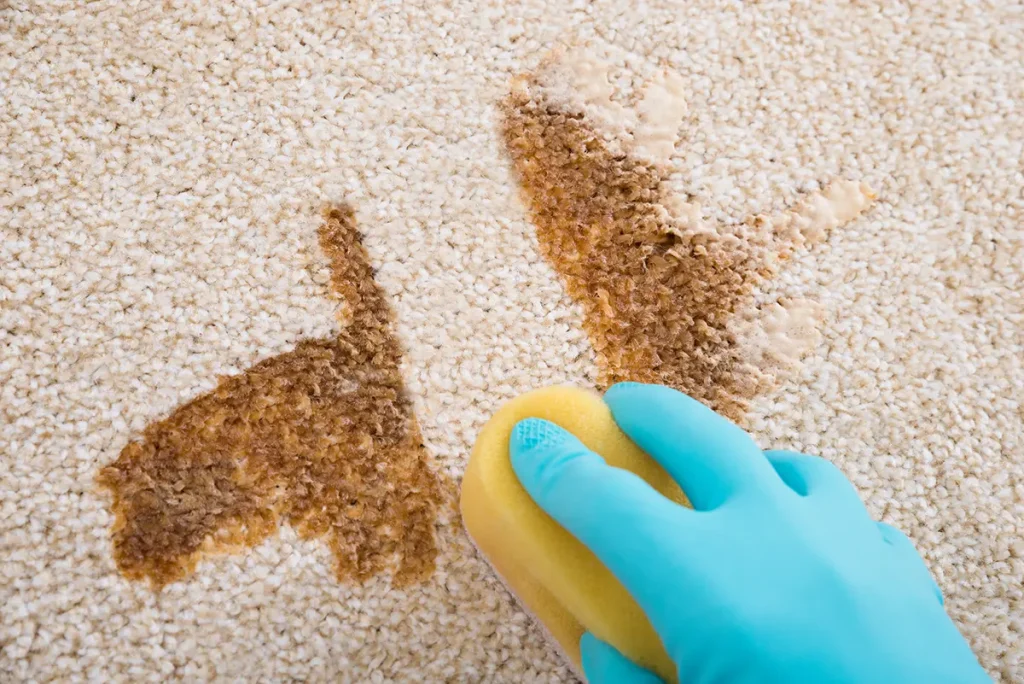
In the event of a mishap, it is important to act promptly in order to prevent a spill from becoming a stubborn stain. Acting quickly and following these steps can make all the difference.
- Use an absorbent material such as a white cloth or paper towel to blot up the spilled substance.
- Work your way towards the center of the stain when cleaning so that it does not spread further.
- Avoid rubbing at all costs, as this will only worsen its appearance.
For common spills like alcohol and soft drinks found in most households, preparing a mixture consisting of 1 teaspoon dish soap, warm water (about 1 quart), and just under 14 teaspoons vinegar may be effective for removing them completely. Apply this solution onto stained areas, then rinse off before dabbing dry with a paper towel; remember that quick action is crucial for avoiding permanent damage!
Deep Cleaning Your Area Rug at Home
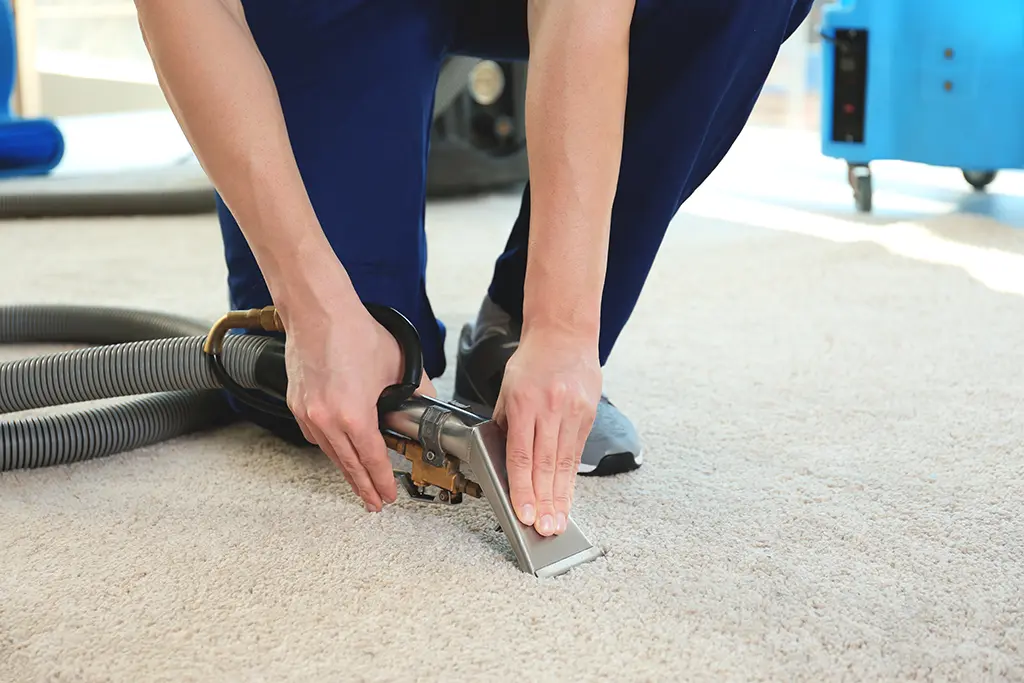
Regular maintenance is essential, but sometimes your carpet may require a thorough, deep cleaning to eliminate dirt and revitalize its appearance. This involves preparing the area and rug, following a specific deep cleaning method, and ensuring proper drying afterward.
To get ready for deep cleaning, begin by vacuuming both sides of the rug to remove all accumulated dust and grime. Then, use some mild detergent or specialized shampoo solution along with a scrubbing brush for an effective cleanse. The process requires tools such as a vacuum cleaner, steam cleaner, detergent product, and stain remover agent.
Preparing Your Space and Rug For Cleaning
Effective preparation is essential for a successful deep cleaning procedure. To begin, clear all furniture and belongings from the rug. If possible, take the rug outside to make cleaning easier and remove any dirt or debris beneath it.
Before starting the deep area rug cleaning, test a small hidden area with your chosen cleaner to ensure it does not damage the color of the rug. Once you have everything ready in your workspace, gather necessary tools such as mild dish soap or specialized rug shampoo solution, a bucket filled with water, a soft-bristle brush or sponge for scrubbing, the garden hose handy, and rubber gloves, a tarp, and spot remover products. The following steps will help guide you through this process – providing detailed advice on how best to tackle each stage effectively.
The Deep Cleaning Process
Now that your space and rug are prepared, it is time to begin the thorough cleaning process. Start by applying a foam carpet-cleaning product or mild detergent solution onto the rug and rub it in as instructed. Then, use either a rinse or vacuum method to remove both the cleaning agent and any dirt that has been loosened.
Remember to protect your rug from potential damage caused by using a vacuum cleaner directly on its surface. Place a nylon screen over the rug first before gently moving back and forth with just enough pressure applied for effective dust removal prior to wetting up the area underneath. Also, be sure to follow recommended sitting periods when utilizing dry shampoo solutions. Avoid mistreatment at all costs during subsequent vacuuming processes.
Drying Your Rug
Properly drying your rug after cleaning is crucial to prevent the growth of mold and mildew. Follow these steps:
- Use a towel to blot any areas that are wet in order to absorb as much water as possible.
- Scrub stains using soapy water with a brush.
- Rinse the rug thoroughly with clear water.
- To ensure even drying, use a towel again for blotting.
Here are some helpful tips for effectively drying your rug.
- Avoid saturating the carpet by not over-wetting it. Alternatively, consider utilizing dry granules specifically designed for cleaning carpets without using any liquid at all.
- Ideally, air-dry outdoors on either clothesline or railing in an area where there is good ventilation present..
- You may also speed up this process by setting up fan/s near while you leave them hanging outside until fully dried out.
Special Considerations for Specialty Rugs
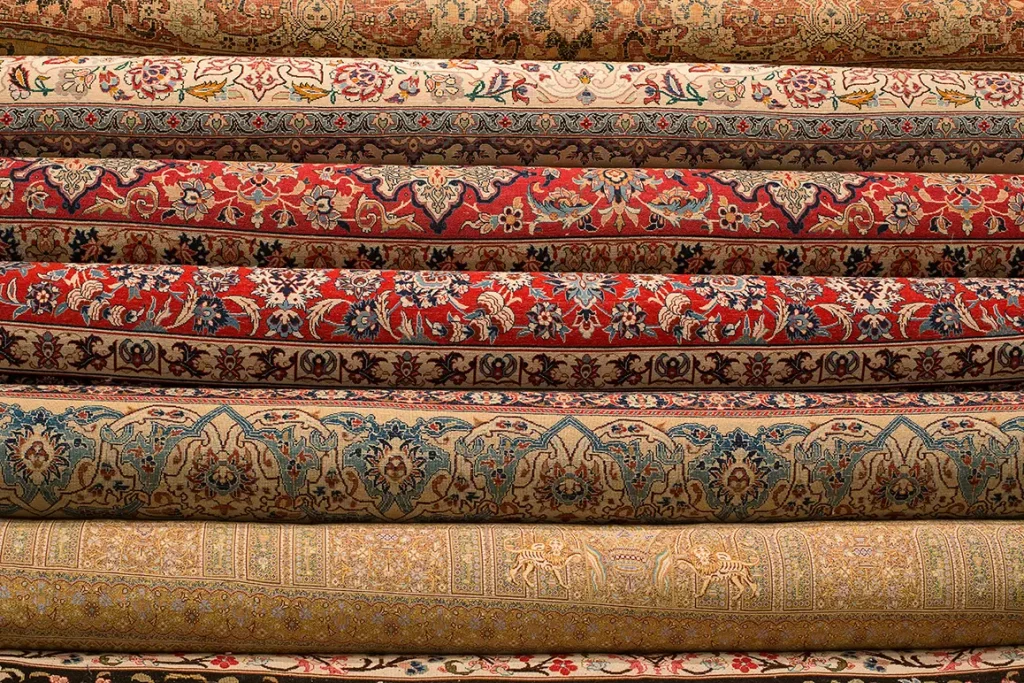
Rugs that fall under the category of specialty, such as antique, oriental, shag, and open weave rugs, require specialized care. This is due to the delicate materials used in making them or the intricate designs woven into them, which necessitates a different approach when it comes to cleaning and maintenance.
When dealing with antique or oriental rugs specifically, it is important to use gentle techniques like hand-washing with pH-balanced shampoo and softly brushing fibers with a soft-bristled brush so as not to cause any damage. On the other hand, shaggy carpets or those made using an open weave technique should be cleaned by either shaking outside or using a rug-beater tool which will effectively remove dirt particles from within.
Handling Delicate Antique and Oriental Rugs
The meticulous designs and intricate craftsmanship of antique and oriental rugs make them highly sought after. Proper care is essential to maintain the quality of these valuable pieces. Here are some useful tips:
- When cleaning your rug, use a mild pH-balanced shampoo and a soft-bristled brush to avoid causing any damage.
- Regularly rotate the rug to prevent uneven wear.
- Keep it away from direct sunlight to protect against fading.
- Regular vacuuming helps remove dirt and dust.
Following these guidelines will help keep your precious antique or oriental rugs in excellent condition for years to come, keeping them flat while preserving their beauty.
If you notice signs of stubborn stains, dirt build-up, fading or have pets/kids who may contribute more grime to your rug, then professional cleaning services might be necessary. These experts possess specialized knowledge/tools that enable gentle handling without damaging delicate fabrics. When done right, maintenance by professionals can restore its pristine appearance, allowing an extended life span. Therefore, it’s advisable(and beneficial) to seek out professional assistance whenever required so as to ensure appropriate upkeep.
Best Practices for Shag Rugs and Rugs with Open Weaves
Cleaning shag rugs and open weave rugs can be a difficult task due to their unique textures. To avoid damaging the fibers, gently vacuum the backside of shag rugs instead of scrubbing too hard or soaking them. For open-weave rugs, it is recommended to shake them outside or use a rug beater to remove dirt and dust particles. Regularly vacuuming these types of rugs, as well as the floor underneath, will help maintain their beauty for many years.
Troubleshooting Common Rug Cleaning Challenges
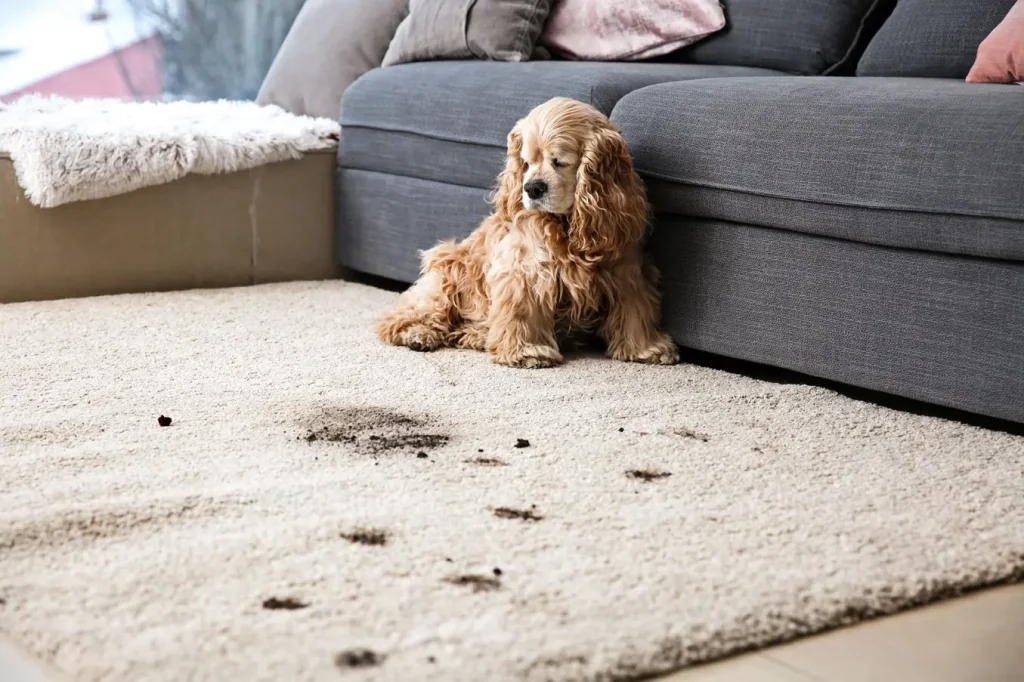
Even if you put in a lot of effort, cleaning your rugs can still come with its own set of challenges. Common problems include:
- Difficulty removing all traces of cleaners used during the process.
- Dealing with unexpected spills and spots.
- Color fading or running.
- Excessive moisture leading to potential mold growth and fiber damage.
To tackle these obstacles, it is helpful to have some strategies on hand. Here are a few tips:
For persistent stains, try using a combination of baking soda and vinegar or soapy water as an effective solution.
Put special focus on regularly vacuuming high-traffic areas where your rug gets the most use.
Using entrance mats near doors can reduce the amount of dirt brought onto the rug by foot traffic.
Be sure to promptly attend to any accidental spills or marks that may occur.
Strategies for Tackling Stubborn Stains
Dealing with stubborn stains during rug cleaning can be a challenge, but there are effective strategies and solutions to tackle them. One option is using homemade remedies like dish detergent solution or a mixture of vinegar and baking soda. Another method is using liquid dish soap such as Dawn for tough stain removal.
Commercial products like Woolite InstaClean, Biokleen Bac-Out Stain, Odor Remover, and Bissell Pro Oxy Power can also work well in removing stubborn stains from rugs. For pet-related stains, sprinkling some baking soda followed by white vinegar and water could do the trick.
For red wine spills on your rug, first blot the stain gently, then use warm water mixed with white vinegar to continue spot-cleaning it before rinsing it off with cold water.
Maintaining Rugs in High Traffic Areas
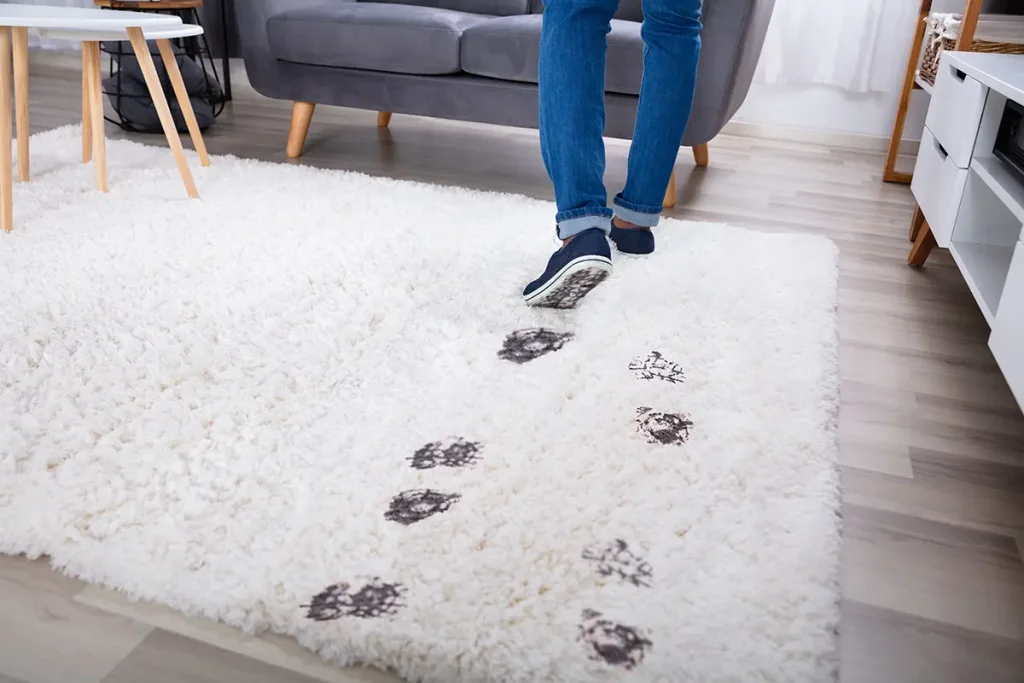
Maintaining rugs in high traffic areas can pose a difficult task as these spaces are more prone to dirt and wear. To ensure cleanliness, frequent vacuuming is necessary while using entrance mats, and promptly addressing spills or stains also helps prevent the buildup of grime.
To withstand heavy footfall, materials like polypropylene, woven vinyl, nylon, and other man-made options prove to be sturdy choices for high-traffic zones. It’s recommended by both experts and manufacturers that such rugs should undergo professional cleaning every 12-18 months or annually if possible.
In order to effectively keep up with maintenance demands, it is important for owners to prioritize regularly caring for their beloved carpets placed at busy spots within their home or workspace. Frequent vacuuming remains critical along with utilizing door mats where shoe brushing may minimize tracking dirt inside. Swiftly dealing with any messes guarantees sustained quality appearance of your valuable area accessory all through its lifetime.
Summary
Achieving the perfect cleaning for your area rug involves several key factors. Understanding the material of your rug, having proper tools and solutions, performing regular maintenance, deep cleaning when necessary, and taking special care of specialty rugs are all important aspects to consider.
To maintain clean carpets, it is essential to have a good understanding of vacuuming techniques and tackle stubborn stains effectively. With some knowledge and effort, keeping pristine rugs can be easily achieved through these steps.
Taking care of your area rug goes beyond maintaining its appearance. It also ensures that the rug lasts longer and keeps your living environment clean and comfortable. By using proper methods and equipment and being consistent with upkeep, you can preserve the beauty of your carpet for a prolonged time. The key to achieving spotless carpets lies in taking responsibility for their maintenance.
Calling a professional cleaner is sometimes necessary, especially when trying to clean natural fiber rugs or antique rugs. These area rugs require special tools and knowledge to achieve the desired results without damaging them. Wool and cotton rugs also fall into this natural fiber rugs category, requiring special attention. Always seek the help of a local professional if you’re not sure how to clean these rugs or are afraid to damage natural fibers.

Frequently Asked Questions
Is it worth cleaning an area rug?
Maintaining the cleanliness of an area rug is crucial in preserving its appearance and ensuring its durability over time. While vacuuming regularly and attending to spills promptly are beneficial, occasional deep cleaning should also be considered for optimal results.
Can I clean my own area rugs?
Cleaning area rugs can easily be done at home. Dust removal methods include either vacuuming or beating them out and for a deeper cleaning, a carpet cleaning solution or dry shampoo can also be used. For smaller rugs, hand washing or using the washer are both effective options to get rid of dirt and stains from your carpets.
How My Carpet Cleaning cleans area rugs?
At the beginning of their cleaning process, we focus on spot-treating any areas that require special care. We then utilize specialized rug cleaning machines to perform a deep clean. These machines pump hot water into the rug in order to effectively release dirt and other particles trapped within it. Finally, they extract all of the water from the rug, leaving behind a thoroughly cleaned and refreshed result.
How often should I vacuum my area rug?
Regularly maintain your area rug by vacuuming it at least once a week. For wool rugs, aim to vacuum them twice a month in order for them to stay looking their best. Both types of rugs require frequent and consistent care through the use of a vacuum.
What are some tips for cleaning antique and oriental rugs?
In order to maintain the quality of your vintage and oriental rugs, it is important to hand-wash them with a mild shampoo that has a balanced pH level. Avoid using harsh chemicals or tools, as they can cause damage to fragile fibers. Instead, opt for a gentle, soft-bristled brush when scrubbing out stains or dirt from your precious rugs. This method will work.

